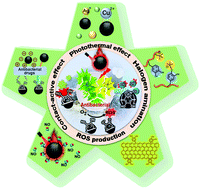Polydopamine antibacterial materials
Abstract
Recently, the development of polydopamine (PDA) has demonstrated numerous excellent performances in free radical scavenging, UV shielding, photothermal conversion, and biocompatibility. These unique properties enable PDA to be widely used as efficient antibacterial materials for various applications. Accordingly, PDA antibacterial materials mainly include free-standing PDA materials and PDA-based composite materials. In this review, an overview of PDA antibacterial materials is provided to summarize these two types of antibacterial materials in detail, including the fabrication strategies and antibacterial mechanisms. The future development and challenges of PDA in this field are also presented. It is hoped that this review will provide an insight into the future development of antibacterial functional materials based on PDA.

- This article is part of the themed collections: Horizons Community Board Collection: Antimicrobial materials and surfaces and Materials Horizons Lunar New Year collection 2022


 Please wait while we load your content...
Please wait while we load your content...